iPWR: Integral Pressurized Water Reactor
The recent announcement by NuScale Power that it had applied for the first ever NRC Design Certification to be considered for a small modular reactor (SMR) has put this class of nuclear reactor again in the fore. Many observers have noted that the NuScale design is "integral," with all significant primary components inside the same vessel. In fact, these two things-integral reactors, and SMRs, are two different things, although either may also be the other. While the application for the NuScale reactor certainly is the first SMR application in the United States, the Integral Pressurized Water Reactor (iPWR) dates back to nearly the start of commercial nuclear energy-and its heritage is at sea.
NS SAVANNAH - Performance-Oriented but Not Idealized
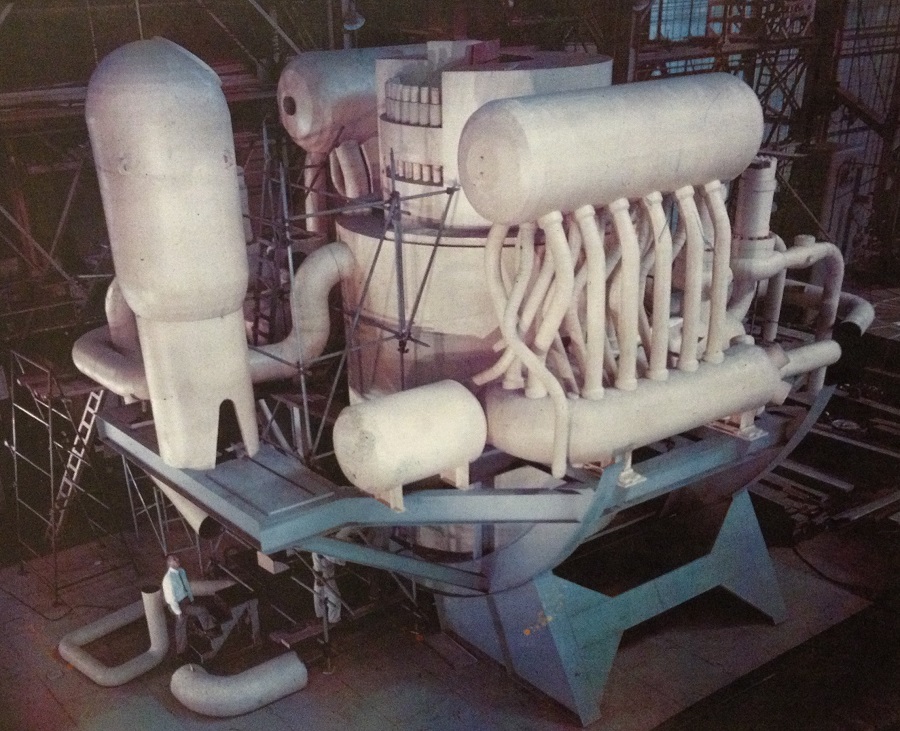
Full size mockup of Nuclear Steam Supply System for NS SAVANNAH. Image courtesy NS Savannah Association.
The decision by President Eisenhower that a commercial nuclear ship prototype would be built carried with it a special, if unwritten, caveat: the propulsion system had to work reliably. To this end, Babcock & Wilcox (B&W), assisted by the Civilian Application Program, moved forward with a conventional (for the day) PWR nuclear steam supply system (NSSS). The much-lauded competitor technologies, specifically high-temperature gas-cooled plants, were not ready when the phone rang, we might say, and thus lost out on this exceedingly important contract and opportunity.
During the 1950s, one of the promises that nuclear energy seemed to confer, at least so far as ships were concerned, was a compactness not equaled by conventional oil-fired boilers or diesel engines (at least, above a certain horsepower rating, for any given technology). That compactness was extrapolated to mean that a reactor could be put anywhere on a ship, which then led to the idea that existing designs could be "converted to nuclear" and perhaps that even existing ships could be converted. Primarily, it was the proponents of the smallest and highest output-per-volume reactor types that pushed this idea forward.
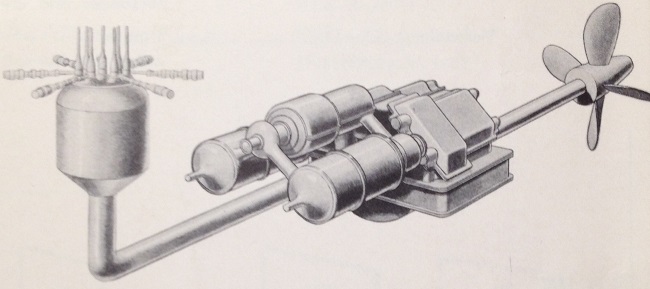
American Turbine gas-cooled shipboard power plant. Will Davis library.
Typical of the proposed but never built high-temperature, compact, and high-efficiency designs being advertised in the mid-late 1950s was the 20,000 SHP American Turbine Company high-temperature gas-cooled reactor/closed-cycle gas turbine plant (from a sales brochure in the author's collection). The comparison between this plant and the NS SAVANNAH NSSS seen earlier (which of course does not illustrate the steam turbines) shows just how much more compact the gas-cooled plants were expected to be.

GM Maritime nuclear plant costs. Will Davis library.
Improved efficiency was perceived in the mid-late 1950s as a major economic driver. Above is a graph taken from a 1957 study performed by the Detroit Diesel Engine Division of General Motors Corporation for the Atomic Energy Commission (AEC), also for a complete gas-cooled, closed-cycle maritime power plant. The improvements in operating economics by increased efficiency as well as by increased core life are obvious, but note that only the highest trace represents a $300/ton machinery cost with all others being $370/ton. Clearly, price mattered. (1)
The NSSS for the NS Savannah was proving, immediately as the ship was designed, to not match the idealized concepts prevalent in the 1950s. The mass of the required containment (and collision protection) certainly did not confer upon designers the ability to simply drop in a reactor anywhere in an already-designed ship. Certainly, it was possible to do better, and B&W (with AEC assistance) moved almost immediately, even prior to the Savannah being fully operational, to design a new more compact power plant-and specifically a more compact NSSS.
Moving from Discrete Components to Integral
B&W's first idea was to select a direct-cycle, boiling water reactor. This was pursued only for a matter of months before another parallel idea emerged to use a compact reactor and a single, conventional U-tube nuclear plant steam generator as seen below.
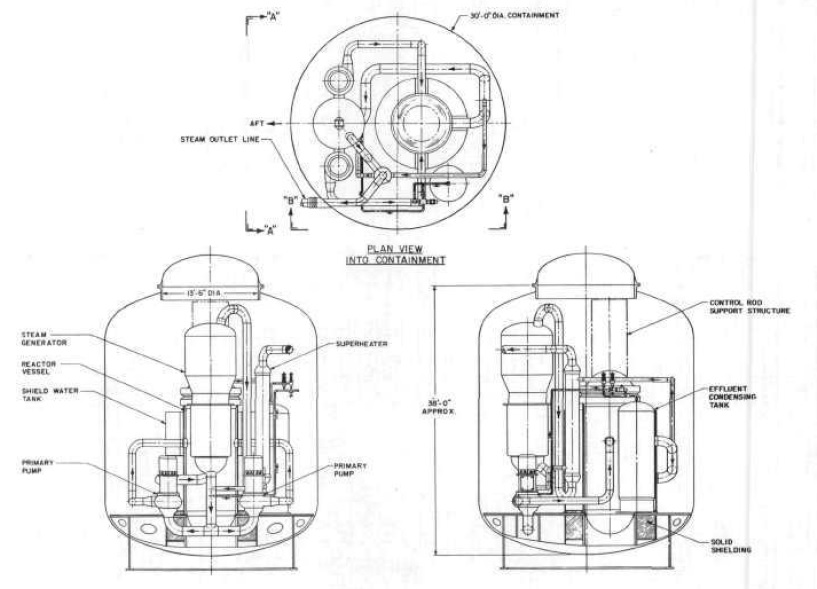
Courtesy N/S Savannah Association.
During the time period of 1960-1961 a couple of rounds of back-and-forth between the AEC and B&W led to further consideration of extreme compactness and improved efficiency. This led to the fundamentally transformative realization that extremely compact designs could be arrived at if the major outer barrier for the NSSS were the reactor vessel, and not the containment. In other words, all of the major NSSS components would be placed inside of, or directly onto, the reactor vessel.
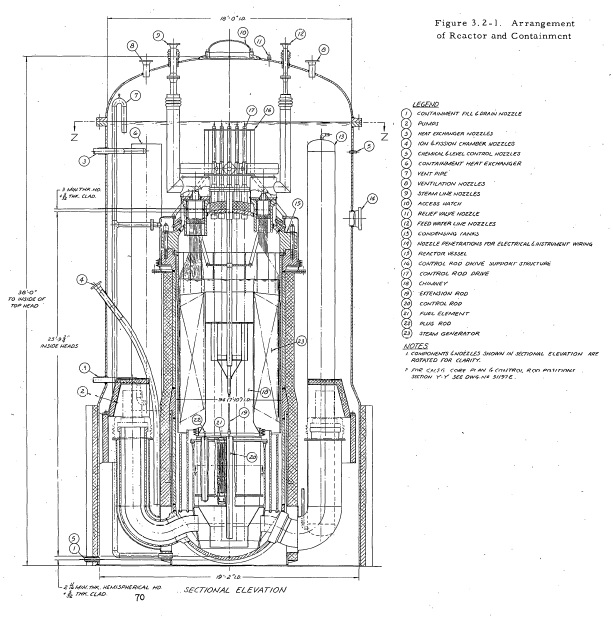
CNSG I, Babcock & Wilcox design of 1962. N/S Savannah Association.
B&W began to use the term consolidated nuclear steam generating system for its new integral PWRs (today referred to in many places as iPWR) and produced first the design seen above. The steam generators are inside the vessel, are single pass, and provide by design up to 70 degrees of steam superheating-adding markedly to the plant efficiency. The nature of the design meant that much of it would be factory assembled and simply installed on site-markedly reducing cost and quality variances. The primary pumps are outside the vessel, mounted on piping branches.
This design was considered good but not necessarily optimal; B&W made a further round of revisions and within a year was offering the CNSG II as seen below.

Babcock & Wilcox CNSG II, 1963. N/S Savannah Association.
Major changes to the CNSG II came from suggestions by the AEC that access for refueling be improved; the new design featured control rod drives mounted radially to the reactor vessel below core height, making the top of the vessel free and clear for refueling (without need to remove a control rod drive package). The coolant pumps were moved on top of the reactor, easing the lift should the motors need to be replaced (as actually would happen once on the NS Savannah, on board which they were extremely difficult to get in and out).
The new integral design of the PWR did finally confer upon designers an ability to consider a wide range of locations for the reactor. Below, an actual U.S. Maritime Administration design for its PD108 type cargo ship with the nuclear plant located well forward of amidships. The turbines would have driven a long propeller shaft to the back of the ship.

MARAD PD108 design; image courtesy N/S Savannah Association
The Integral PWR Enters Service
By 1959 discussion in West Germany had reached a point that serious money was being spent to develop a commercial nuclear powered ship vaguely along the lines of the American NS Savannah although somewhat smaller (38 MWt and 10,000 shaft horsepower, vs. the American ship's 69 MWt, later 80 MWt after uprate and 22,000 shaft horsepower). In 1960, the decision was made to proceed. It was realized that the most mature technology that was considered advanced was in fact the still-new iPWR, and this was selected for the ship in the form of the B&W CNSG I.
B&W's German subsidiary constructed the nuclear steam supply for the ship, which was appropriately named Otto Hahn and which was laid down in 1963. The reactor was first started up in 1968, and proved a complete success (just as had the power plant of NS Savannah) over an operational period of 10 years.

German nuclear powered merchant ship OTTO HAHN; press photo in Will Davis library

Nuclear reactor (left) and fuel storage (right) spaces of Otto Hahn, courtesy Peter von Dobschuetz, FRG Environment Ministry.
Competition Awakens
The concept of an iPWR quickly moved from being novel (around 1961) to fully commercial (concurrent with the order for Otto Hahn's NSSS), and competing firms moved to design their own intergral PWRs for maritime service although these, like the B&W CNSG series were all later offered as the basis for reduced cost, relatively fast-availability commercial nuclear plants on land.
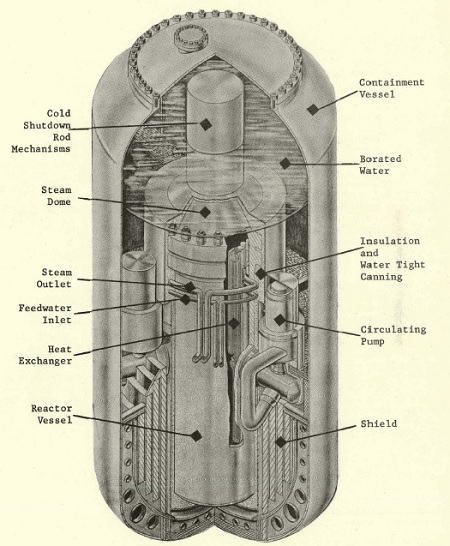
Combustion Engineering UNIMOD integral PWR and containment. From COO-284, Small Nuclear Power Plants Vol. II, US AEC 1967.
Combustion Engineering (CE) developed what it called a Unified Modular Plant for Marine Propulsion, which it generally referred to as the UNIMOD design. This integral PWR-based plant had the novel feature that control of temperature and power was to be entirely controlled by steam demand, with no control rods installed except safety rods used to force core shutdown. According to estimates the total assembled weight of the equipment seen above was 325 long tons, with a reactor sized at 80 MWt. The reactor vessel itself was to be 72 inches inside diameter and 22 feet high.
United Nuclear Corporation offered a pair of integral PWR designs typified by the below drawing.

United Nuclear Corporation U1U / U2U overall design of integral PWR and containment. From COO-284, Small Nuclear Power Plants, US AEC 1967.
The United Nuclear concept was available in two different outputs, one much larger than the highest offered by CE; however, the design used a much more conventional control scheme with control rods in play at all times.
As we now know, none of the more modern US iPWR designs was built. The Maritime Administration never did get another nuclear ship, and the broad perceived demand for such ships in the 1950s and 1960s never panned out for a large variety of reasons (including purchase cost, insurance, crew pay rates, and others). What's more, in continued rounds of detailed designs of nuclear powered merchant ships, one of the fundamental concepts of compact design was proven wrong-that of "universally positioned reactors." It turned out that simply inserting a nuclear plant into an existing design would have been incredibly uneconomical; nuclear powered ships, because of their expense, needed to be specially designed to incorporate other features to make them both faster than other ships and faster to load/unload in order for them to be economically viable. Simply "dropping in a reactor" was out, and thus one of the reasons behind developing these compact iPWR units was now obsolete.
Still, for a long time, plan after plan was made to incorporate such reactors into hopefully inexpensive land based nuclear power plants, but until the start of the year 2017, none of these made it to the level of approval by the AEC/Nuclear Regulatory Commission. That's a long time to wait. What's important to realize now, especially in the face of criticism that new integral SMRs have never existed and aren't proven, is that integral PWRs existed a half century ago in operational service, designed from solid engineering goals, and succeeded.
(1) An interesting sidelight is the fact that this study under General Motors' name was in reality performed for it, under contract, by Internuclear Corporation. Given the nature of GM in those years, it seems likely that should the proposal have been picked up by the AEC, GM would probably have simply purchased and merged Internuclear to keep the program moving. GM had a habit of doing this to incorporate important fields; it did this with Fisher Auto Body, and the Electro-Motive Corporation just to name two.
 Will Davis is Communications Director and board member for the N/S Savannah Association, Inc. He is a consultant to the Global America Business Institute, a contributing author for Fuel Cycle Week, and he writes his own popular blog Atomic Power Review. Davis is also a consultant and writer for the American Nuclear Society, and serves on the ANS Communications Committee and on the Book Publishing Committee. He is a former U.S. Navy reactor operator and served on SSBN-641, USS Simon Bolivar. He takes great interest in the long gone Maritime Reactors program, which in part led to this article.
Will Davis is Communications Director and board member for the N/S Savannah Association, Inc. He is a consultant to the Global America Business Institute, a contributing author for Fuel Cycle Week, and he writes his own popular blog Atomic Power Review. Davis is also a consultant and writer for the American Nuclear Society, and serves on the ANS Communications Committee and on the Book Publishing Committee. He is a former U.S. Navy reactor operator and served on SSBN-641, USS Simon Bolivar. He takes great interest in the long gone Maritime Reactors program, which in part led to this article.

